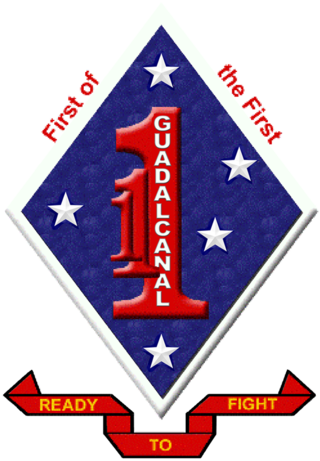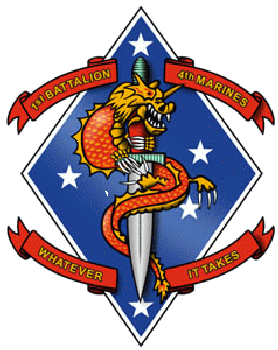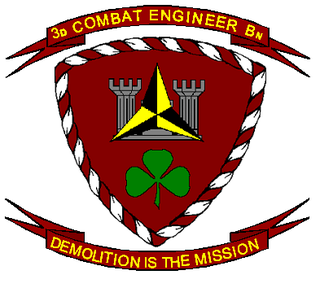
The Amphibious Vehicle, Tracked (LVT) is an amphibious warfare vehicle and amphibious landing craft, introduced by the United States Navy and United States Marine Corps. The United States Army, Canadian Army and British Army used several LVT models during World War II, and referred to those vehicles as "Landing Vehicle, Tracked."

The 5th Marine Division was a United States Marine Corps ground combat division which was activated on 11 November 1943 at Camp Pendleton, California during World War II. The 5th Division saw its first combat action during the Battle of Iwo Jima in 1945 where it sustained the highest number of casualties of the three Marine divisions of the V Amphibious Corps. The 5th Division was to be part of the planned invasion of the Japan homeland before Japan surrendered. Assault troops of the 5th Division were included in the Presidential Unit Citation awarded to the V Amphibious Corps for extraordinary heroism on Iwo Jima from 19 to 28 February 1945. The 5th Division was deactivated on 5 February 1946.

1st Battalion, 1st Marines (1/1) is an infantry battalion in the United States Marine Corps based out of Camp Pendleton, California, consisting of anywhere from 800 to 2,000 Marines and Sailors, but the number fluctuates depending on the battalion's mission. Falling under the command of the 1st Marine Regiment and the 1st Marine Division, they are commonly referred to as "The first of the First".
Radio Battalions are tactical signals intelligence units of Marine Corps Intelligence. There are currently three operational Radio Battalions in the Marine Corps organization: 1st, 2nd, and 3rd. In fleet operations, teams from Radio Battalions are most often attached to the command element of Marine Expeditionary Units.

1st Battalion, 5th Marines (1/5) is an infantry battalion in the United States Marine Corps based out of Marine Corps Base Camp Pendleton, California consisting of approximately 800 Marines and sailors. Nicknamed Geronimo, it falls under the command of the 5th Marine Regiment and the 1st Marine Division. The battalion was formed in 1914 and has served in every major conflict that the United States has been involved in since then.

2nd Battalion, 3rd Marines (2/3) was an infantry battalion in the United States Marine Corps based out of Marine Corps Base Hawaii consisting of approximately 1,000 Marines and sailors. The battalion fell under the command of the 3rd Marine Regiment and the 3rd Marine Division. The battalion was deactivated in January 2022 as part of the Marine Corps' ongoing Force Design efforts.

2nd Battalion, 11th Marines (2/11) is an artillery battalion comprising four firing batteries and a Headquarters Battery. The battalion is stationed at Marine Corps Base Camp Pendleton, California. Its primary weapon system is the M777 lightweight howitzer. The battalion was the first in the Marine Corps to fully transition from the M198 Howitzer. They fall under the command of the 11th Marine Regiment and the 1st Marine Division.

1st Battalion, 4th Marines (1/4) is an infantry battalion in the United States Marine Corps based out of Marine Corps Base Camp Pendleton, California consisting of approximately 800 Marines and sailors. They fall under the command of the 1st Marine Regiment and the 1st Marine Division.

The 1st Battalion, 6th Marines (1/6) is an infantry battalion in the United States Marine Corps based in Camp Lejeune, North Carolina. It consists of approximately 1,100 marines and sailors. They fall under the command of the 6th Marine Regiment, the 2nd Marine Division of the II Marine Expeditionary Force.

3rd Battalion, 23rd Marine Regiment (3/23) is a reserve infantry battalion in the United States Marine Corps located throughout the Southern United States consisting of approximately 800 Marines and Sailors. The battalion was first formed in 1943 for service in the Central Pacific Area during World War II, taking part in a number of significant battles including those at Saipan and Iwo Jima before being deactivated at the end of the war. In the early 1960s, the unit was reactivated as a reserve battalion. The battalion is headquartered in Saint Louis, Missouri, with outlying units throughout the Southern United States. 3/23 falls under the command of the 23rd Marine Regiment and the 4th Marine Division. Recent operations have included tours in Iraq and Afghanistan.

The 4th Assault Amphibian Battalion is a mechanized battalion of the United States Marine Corps Reserve. Their primary weapon system is the AAV-P7/A1 Amphibious Assault Vehicle and they are part of the 4th Marine Division of the Marine Forces Reserve. The unit is based out of Marine Corps Reserve Center (MARCORESCEN) Tampa, Florida, with subordinate units at MARCORESCEN Galveston, Texas; MARCORESCEN Jacksonville, Florida; and MARCORESCEN Norfolk at Joint Expeditionary Base Little Creek-Fort Story, Virginia.

The 7th Engineer Support Battalion is an engineer support unit of the United States Marine Corps and is headquartered at Marine Corps Base Camp Pendleton, California. The unit falls under the command of 1st Marine Logistics Group and the I Marine Expeditionary Force.

2nd Assault Amphibian Battalion is one of two active duty assault amphibian battalions in the United States Marine Corps. The battalion is tasked with transporting US Marine forces and their equipment from assault ships to shore, and equipped with the Amphibious Combat Vehicle (ACV), which replaced the Amphibious Assault Vehicle (AAV). The battalion is part of the 2nd Marine Division and the II Marine Expeditionary Force. The unit is based in Camp Lejeune in North Carolina.

The Combat Assault Battalion was a mechanized battalion of the United States Marine Corps and subordinate element of the 3rd Marine Division and the III Marine Expeditionary Force. The unit was last based at Camp Schwab, Okinawa, Japan.

1st Medical Battalion is a unit of the United States Marine Corps operated by the United States Navy that provides expeditionary Health Service Support to Marine Corps forces forward deployed to operations or humanitarian missions. The unit is based out of Marine Corps Base Camp Pendleton and falls under the command of 1st Marine Logistics Group.

The 11th Marine Expeditionary Unit is one of seven Marine Expeditionary Units currently in existence in the United States Marine Corps. The Marine Expeditionary Unit is a Marine Air Ground Task Force with a strength of about 2,200 personnel. The MEU consists of a command element, a reinforced infantry battalion, a composite helicopter squadron and a logistics combat element. The 11th MEU is currently based out of Marine Corps Base Camp Pendleton, California with headquarters in Camp Del Mar.

Combat Logistics Battalion 15 (CLB-15) is a military logistics battalion in the United States Marine Corps based out of Camp Pendleton, California. It consists of approximately 275 Marines and Sailors. It is part of Combat Logistics Regiment 17 within the 1st Marine Logistics Group, I Marine Expeditionary Force. When assigned under the operational control of the 15th Marine Expeditionary Unit, it becomes the Logistics Combat Element (LCE) providing expeditionary combat logistics support to all supported elements of the Marine Expeditionary Unit. CLB-15 has two sister MEU CLBs also based out of Camp Pendleton: CLB-11 and CLB-13.
In the United States Marine Corps, the ground combat element (GCE) is the land force of a Marine Air-Ground Task Force (MAGTF). It provides power projection and force for the MAGTF.

3rd Combat Engineer Battalion was a combat engineer battalion of the United States Marine Corps, most recently activated from 7 October 2007 to 5 August 2014. 3rd CEB is having a reunion in Neihart, Montana May 19-22 2023 being hosted by Warrior Reunion Foundation.
























